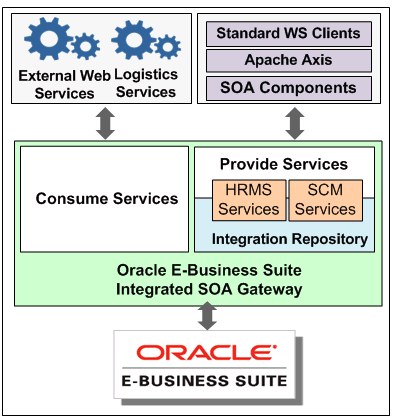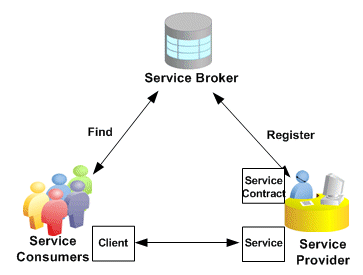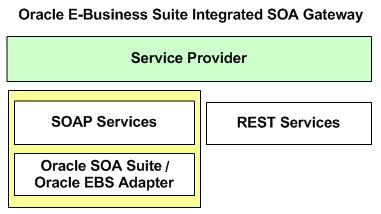Oracle E-Business Suite Integrated SOA Gateway Overview
Oracle E-Business Suite Integrated SOA Gateway Overview
Building on top of Oracle Fusion Middleware and service-oriented architecture (SOA) technology, Oracle E-Business Suite Integrated SOA Gateway (ISG) is a complete set of service infrastructure to provide, consume, and administer Oracle E-Business Suite web services.
With service enablement feature, integration interfaces published in the Oracle Integration Repository can be transformed into SOAP and REST based services.
By leveraging Oracle SOA Suite running on Oracle WebLogic Server, Oracle E-Business Suite Integrated SOA Gateway provides greater capabilities and infrastructure for exposing various integration interfaces within Oracle E-Business Suite as SOAP services. SOAP-based services are described in WSDLs and are deployed to Oracle SOA Suite for service consumption.
Unlike SOAP services, REST services, without the dependency on Oracle SOA Suite, are developed with the infrastructure of Oracle E-Business Suite. REST services described in WADLs are directly deployed to an Oracle E-Business Suite WebLogic environment. They can be used for user-driven applications such as Oracle E-Business Suite mobile applications.
Oracle E-Business Suite Integrated SOA Gateway provides Service Invocation Framework to invoke and consume web services provided by other applications.
Major Features
Oracle E-Business Suite Integrated SOA Gateway can do the following:
-
Display all Oracle E-Business Suite integration interface definitions through Oracle Integration Repository
-
Support custom integration interfaces from Oracle Integration Repository
-
Provide service enablement capability (SOAP and REST services) for seeded and custom integration interfaces within Oracle E-Business Suite
-
Use the Integration Repository user interface to perform design-time activities such as generate and deploy Oracle E-Business Suite web services
-
Support synchronous and asynchronous (callback without acknowledgement only) interaction patterns for SOAP-based services
Note: In this release, only PL/SQL APIs can be enabled with the support for asynchronous service pattern.
-
Support synchronous interaction pattern for REST-based services
Note: In this release, only PL/SQL APIs, Concurrent Programs, Business Service Objects, Java Bean Services, Application Module Services, Open Interface Tables, and Open Interface Views can be exposed as REST services.
-
Support multiple authentication types for inbound service requests in securing web service content
-
Enforce function security and role-based access control security to allow only authorized users to process administrative functions
-
Provide centralized, user-friendly logging configuration for the services generated through the service provider from Oracle E-Business Suite Integrated SOA Gateway
-
Audit and monitor Oracle E-Business Suite inbound service operations from Service Monitor
-
Audit and monitor outbound service invocations from Oracle E-Business Suite through Service Invocation Monitor
-
Leverage Oracle Workflow Business Event System to enable service invocation from Oracle E-Business Suite
Major Components Features and Definitions
Oracle E-Business Suite Integrated SOA Gateway provides two major service offerings:
-
Providing Services
Oracle E-Business Suite interfaces resided in Oracle Integration Repository can be service enabled through service provider. The service enablement is the key feature within the Oracle E-Business Suite Integrated SOA Gateway.
Once services are deployed, web service clients send request messages and then invoke Oracle E-Business Suite services. All these inbound SOAP and REST service invocation messages can be monitored and audited through Service Monitor. See: Monitoring and Managing Inbound Service Invocation Messages Using Service Monitor.
-
Consuming Services
In addition to providing services, Oracle E-Business Suite Integrated SOA Gateway can consume external services through Service Invocation Framework.
All outbound SOAP and REST service invocations and associated request and response messages through Service Invocation Framework can be monitored and audited using Service Invocation Monitor. See: Monitoring and Managing Outbound Service Invocation Messages Using Service Invocation Monitor.
Oracle E-Business Suite Integrated SOA Gateway Functional Flow Diagram

To better understand Oracle E-Business Suite Integrated SOA Gateway, the next sections explain essential components and how each component is used.
Enabling Oracle E-Business Suite Web Services
Service enablement is the key feature within Oracle E-Business Suite Integrated SOA Gateway. It provides a mechanism that allows native packaged integration interface definitions resided in Oracle Integration Repository to be transformed into web services. SOAP services are deployed from the Integration Repository to Oracle SOA Suite allowing more consumptions over the web. REST services are deployed to Oracle E-Business Suite.
The basic concept of web service components is illustrated in the following diagram:
Web Service Components

-
Service Provider is the primary engine underlying the web services. It acts as a bridge between Oracle E-Business Suite and Oracle SOA Suite to facilitate the service enablement for various types of Oracle E-Business Suite interfaces.
Note: In earlier Oracle E-Business Suite Releases, SOA Provider and Web Service Provider were used in enabling Oracle E-Business Suite services. In the Release 12.2, Service Provider is the engine for service enablement.
Service Provider leverages Oracle SOA Suite for provisioning Oracle E-Business Suite SOAP-based services. It is the engine that performs the actual service generation and deployment behind the scene.
-
Service Consumer (Web Service Client) is the party that uses or consumes the services provided by the Service Provider.
-
Service Broker (Service Registry) describes the service's location and contract to ensure service information is available to potential service consumers.
Oracle Integration Repository and Service Enablement
Oracle Integration Repository, an integral part of Oracle E-Business Suite, is the centralized repository that contains numerous interface endpoints exposed by applications within the Oracle E-Business Suite. It supports the following interface types:
-
PL/SQL
-
XML Gateway
-
Concurrent Programs
-
Business Events
-
Open Interface Tables and Open Interface Views
-
EDI
-
Business Service Object (Service Beans)
-
Java
Apart from normal Java APIs, Java interface includes the following subcategories:
-
Application Module Services
Note: Application Module Implementation class is a Java class that provides access to business logic governing the OA Framework-based components and pages. Such Java classes are called Application Module Services and are categorized as a subtype of Java interface.
-
Java Bean Services
Note: Java APIs whose methods use parameters of either simple data types or serializable Java Beans are categorized as Java Bean Services. Such Java APIs can be exposed as REST-based web services.
-
Security Services
Note: Security Services are a set of predefined and predeployed REST services from Oracle Application Object Library. These services include Authentication and Authorization services for mobile applications. These services are built on Java; therefore, they are categorized as a subtype of Java interface.
In this release Java APIs for Forms are not serviceable interfaces and cannot be exposed as SOAP services. Refer to My Oracle Support Knowledge Document 966982.1 for the suggested alternatives to the existing Java APIs for Forms interfaces.
-
-
Composite Interfaces
Oracle E-Business Suite Integrated SOA Gateway leverages Oracle Integration Repository to provide the capabilities of service generation and deployment, as well as service life cycle management.
Note: Not all the interface types resided in the Integration Repository can be service enabled. The supported interface types for service enablement are XML Gateway, PL/SQL, Concurrent Program, Business Service Object, Application Module Services, Java Bean Services, Open Interface Tables, and Open Interface Views.
As mentioned earlier, security services are pregenerated REST services from Oracle Application Object Library. Therefore, there is no need to enable the security services from the repository as required by other supported interface types.
Web Service Security
To protect application data from unauthorized access, Oracle E-Business Suite integrated SOA Gateway enforces the security rules through subject authentication and authorization:
-
To authenticate users who request Oracle E-Business Suite services, request messages must be checked based on the selected authentication type:
-
The SOAP messages must be authenticated using the UsernameToken or SAML Token based security. The identified authentication information is embedded in the
wsse:securityWeb Security headers. -
The REST messages are authenticated using the HTTP Basic Authentication security (either user name/password or security token) at the HTTP transport level.
-
-
To authorize users on specific services or operations, the access permissions must be explicitly given to the users through security grants. Multiple organization access control (MOAC) security rule is also implemented for authorizing interface access related to multiple organizations.
Additionally, input message header (such as SOAHeader and RESTHeader) is used to pass the application context needed in invoking Oracle E-Business Suite services as part of the subject authorization.
Service Monitor
Service Monitor is a centralized, light-weight service monitoring and management tool.
It fetches data and statistics for each instance of service request and response messages and lets administrators monitor all inbound Oracle E-Business Suite service invocations provided through Oacle E-Business Suite Integrated SOA Gateway. Use Service Monitor to view the runtime request and response data received and sent directly to Oracle E-Business Suite for REST services and the runtime messages passed through Oracle SOA Suite for SOAP services.
For more information about Service Monitor, see Monitoring and Managing Inbound Service Invocation Messages Using Service Monitor.
Service Invocation Framework
By leveraging Oracle Workflow Java Business Event System (JBES), Service Invocation Framework (SIF) provides the capability of invoking SOAP and REST services from Oracle E-Business Suite.
It provides an infrastructure allowing developers to interact with SOAP and REST services through service endpoint descriptions. For detailed implementation information, see Implementing SOAP and REST Service Invocation Framework.
Service Invocation Monitor
Service Invocation Monitor is also a service monitoring and management tool. It tracks all outbound service invocations from Oracle E-Business Suite through Service Invocation Framework.
Administrators use Service Invocation Monitor to view each instance of the runtime request and response messages sent and received through Service Invocation Framework. For more information about Service Invocation Monitor, see Monitoring and Managing Outbound Service Invocation Messages Using Service Invocation Monitor.
Native Service Enablement Architecture Overview
Oracle E-Business Suite Integrated SOA Gateway employs essential components that enable service integration at design time and runtime, and ease the service management throughout the entire service deployment life cycle.
Service Provider is the primary engine enabling the Oracle E-Business Suite services. It is the engine that performs the actual service generation and deployment behind the scene for both SOAP and REST services.
-
In SOAP-based service enablement, it leverages Oracle SOA Suite and Oracle Applications Adapter (also called Oracle E-Business Suite Adapter) for provisioning standard web services for business integration.
-
In REST-based service enablement, it provides light weight, out-of-box services for mobile applications and chatty UI applications.
The high level service enablement diagram can be illustrated in the following diagram:

SOAP Service Enablement Architecture and Design Time
SOAP services, once successfully generated, are deployed to an Oracle SOA Suite WebLogic environment. The seamless integration between Oracle E-Business Suite and Oracle SOA Suite forms the Oracle E-Business Suite Integrated SOA Gateway architecture.

-
Oracle E-Business Suite on Oracle WebLogic Server
Oracle E-Business Suite is integrated with Oracle WebLogic Server (WLS) to provide a complete set of service infrastructure with great flexibility.
Oracle WebLogic Server is an application server that provides an implementation of Java Platform Enterprise Edition (Java EE, formerly known as J2EE) specification. Its infrastructure enables enterprises to deploy mission-critical applications in a robust, secure, and highly scalable environment and is an ideal foundation for building applications based on service-oriented architecture.
An Oracle WebLogic Server can include many domains. A domain is an administrative unit or boundary that provides for a single point of administration for a collection of servers. Therefore, a single domain comprises one administration server and one or more managed servers.
For more information on Oracle WebLogic Server features and system administration, see the Oracle Fusion Middleware Introduction to Oracle WebLogic Server.
-
Oracle SOA Suite on Oracle WebLogic Server
Oracle SOA Suite is an essential middleware layer of Oracle Fusion Middleware. It contains full range of service components for designing, deploying, and managing composite applications. Furthermore, Oracle SOA Suite provides various integrated capabilities, such as messaging, orchestration, web services management, business monitoring, and so on. These capabilities facilitate the service integration between various enterprises in different platforms.
With seamless integration with Oracle SOA Suite, Oracle E-Business Suite Integrated SOA Gateway becomes a self-contained web application. Oracle E-Business Suite integration interfaces can be exposed as web services through SOA Composites in Oracle SOA Suite.
At design time, an integration developer or integration administrator can select a desired interface and perform the service generation from the repository.
Once the service artifact has been generated, an integration administrator can deploy the service from Oracle Integration Repository to an Oracle SOA Suite WebLogic environment where the soa-infra application is running.
Note: Users with different roles can perform various tasks in Oracle E-Business Suite Integrated SOA Gateway. Each user role representing a unique permission or permission set can be granted to appropriate users. For example, an integration administrator defined by the Integration Administrator role can perform design-time operations, and other administrative tasks. For information on user roles and how to grant roles to users, see Assigning User Roles and Role-Based Access Control (RBAC) Security for Oracle E-Business Suite Integrated SOA Gateway.
REST Service Design Time
Without the dependency on Oracle SOA Suite, REST services are developed based on Oracle E-Business Suite technology infrastructure.
At design time, an integration administrator can select desired methods to be exposed as REST service operations before deploying them to Oracle E-Business Suite.
Additionally, the administrator can undeploy the service if needed.
Service Enablement Runtime
Oracle E-Business Suite integration interfaces can be exposed as web services and interacted with web service clients at runtime.
When service consumers or web service clients send request messages at runtime, before invoking deployed services in the managed servers, all service-related security and policies are enforced. After authenticating the requests, Oracle E-Business Suite web services can be invoked. Service response messages will be sent back to the web service clients if needed.
For each service operation, SOAP request and response messages passed through Oracle SOA Suite and REST messages received directly to Oracle E-Business Suite are captured in Service Monitor where all Oracle E-Business Suite service activities processed at runtime can be monitored.
For more information on how to monitor web service messages in Service Monitor, see Monitoring and Managing Inbound Service Invocation Messages Using Service Monitor.
Additionally, Oracle E-Business Suite Integrated SOA Gateway can consume external services. Each instance of the runtime request and response messages sent and received through service invocation framework can be tracked and monitored in Service Invocation Monitor. For more information about Service Invocation Monitor, see Monitoring and Managing Outbound Service Invocation Messages Using Service Invocation Monitor.
Web Service Clients
Customers or third parties can use the following standard web service client technologies or tools to invoke Oracle E-Business Suite services:
-
Apache Axis
Apache Axis is an open source, XML-based web service framework for constructing SOAP processors such as clients, servers, gateways, etc. It consists of a Java and a C++ implementation of the SOAP server, and various utilities and APIs for generating and deploying service applications. It can help create, publish, and consume services.
-
.NET Web Service Client
.NET web service client enables you to create services and call these services from any client application.
-
Oracle JDeveloper
Oracle JDeveloper is used to help create web service clients through Java SOAP APIs.
-
Oracle BPEL Process Manager
Business process execution language (BPEL) is particularly used in orchestrating complex business processes in a SOA composite application.
-
Oracle Service Bus (OSB)
Oracle Service Bus provides enterprise service level mediation. It can be used for simple transactional service to transport and route messages between service consumers and service providers.